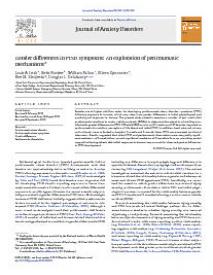Gender differences in PTSD symptoms : An exploration of peritraumatic mechanisms
Females are at higher risk than males for developing posttraumatic stress disorder symptoms (PTSS) following exposure to trauma, which may stem from gender differences in initial physiological and psychological responses to trauma. The present study aimed to examine a number of peri- and initial posttraumatic reactions to motor vehicle accidents (MVAs) to determine the extent to which they contributed to gender differences in PTSS. 356 adult MVA survivors (211 males and 145 females) reported on peritraumatic dissociation, perception of life threat and initial PTSS. In addition, heart rate and urinary cortisol levels were collected in-hospital. 6 weeks and 6 months later, PTSS were assessed via clinical interviews. Results suggested that initial PTSS and peritraumatic dissociation were marginally significant mediators at 6-week follow-up and significant mediators at 6-month follow-up, providing partial support for the hypothesis that initial responses to trauma may account for observed gender differences in PTSS development.
Geachte bezoeker,
De informatie die u nu opvraagt, kan door psychotraumanet niet aan u worden getoond. Dit kan verschillende redenen hebben,
waarvan (bescherming van het) auteursrecht de meeste voorkomende is. Wanneer het mogelijk is om u door te verwijzen naar de bron
van deze informatie, dan ziet u hier onder een link naar die plek.
Als er geen link staat, kunt u contact opnemen met de bibliotheek,
die u verder op weg kan helpen.
Met vriendelijke groet,
Het psychotraumanet-team.
In: journal of Anxiety Disorders ISSN: 0887-6185 | 25 | 2 | 209-216
https://doi.org/10.1016/j.janxdis.2010.09.004


